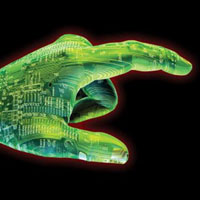2010 marks a year of advances for SMU scientists and their research
SMU scientists are in the forefront of those seeking solutions to some of the world's greatest challenges.

By Margaret Allen
SMU News
From picking apart atomic particles at Switzerland's CERN, to unraveling the mysterious past, to delving into the human psyche, SMU researchers are in the vanguard of those helping civilization understand more and live better.
With both public and private funding — and the assistance of their students — they are tackling such scientific and social problems as brain diseases, immigration, diabetes, evolution, volcanoes, panic disorders, childhood obesity, cancer, radiation, nuclear test monitoring, dark matter, the effects of drilling in the Barnett Shale, and the architecture of the universe.
"Research at SMU is exciting and expanding," says James E. Quick, Associate Vice President for Research and Dean of Graduate Studies. "Our projects cover a wide range of problems in basic and applied research, from the search for the Higgs particle at the Large Hadron Collider in CERN to the search for new approaches to treat serious diseases.
"The University looks forward to creating increasing opportunities for undergraduates to become involved as research expands at SMU," says Quick, who is also a professor in the Huffington Department of Earth Sciences and an expert in volcanoes.
A sample of research by SMU scientists:
CERN and the origin of our universe

Compounds to fight neurodegenerative diseases
Synthetic organic chemist and Chemistry Professor Edward Biehl leads a team developing organic compounds for possible treatment of neurodegenerative diseases such as Parkinson’s, Huntington’s and Alzheimer’s. Preliminary investigation of one compound found it was extremely potent as a strong, nontoxic neuroprotector in mice.

Robotic arms for injured war vets
Electrical Engineering Chairman and Professor Marc Christensen is director of a new $5.6 million center funded by the Department of Defense and industry. The center will develop for war veteran amputees a high-tech robotic arm with fiber-optic connectivity to the brain capable of “feeling” sensations such as hot and cold.
Paleoclimate in humans’ first environment

A system of monitoring breathing to reduce CO2 intake is proving useful for reducing the pain of chronic asthma and panic disorder in separate studies by Associate Psychology Professor Thomas Ritz and Assistant Psychology Professor Alicia Meuret.
Breast Cancer community engagement

Green energy from the Earth’s inner heat
The SMU Geothermal Laboratory, under Earth Sciences Professor David Blackwell, has identified and mapped U.S. geothermal resources capable of supplying a green source of commercial power generation, including resources that were much larger than expected under coal-rich West Virginia.
Exercise can be magic drug for depression and anxiety

Virtual reality “dates” to prevent victimization
Psychology Department Chairman and Professor Ernest Jouriles led (or leads?) a team of psychologists and SMU Guildhall in developing an interactive video gaming environment where women on virtual-reality dates can learn and practice assertiveness skills to prevent sexual victimization.
Pacific Ring of Fire volcano monitoring

An expert on the locomotion of humans and other terrestrial animals, Associate Professor of Applied Physiology and Biomechanics Peter Weyand has analyzed the biomechanics of world-class athletes Usain Bolt and Oscar Pistorius. His research targets the relationships between muscle function, metabolic energy expenditure, whole body mechanics and performance.
Understanding How Humans Evolved

Assistant Professor of Physics Jodi Cooley belongs to a high-profile international team of physicists searching for elusive dark matter — believed to constitute the bulk of the matter in the universe — at an abandoned underground mine in Minnesota, and soon at an even deeper mine in Canada.
Controlled drug delivery agents for diabetes

# # #